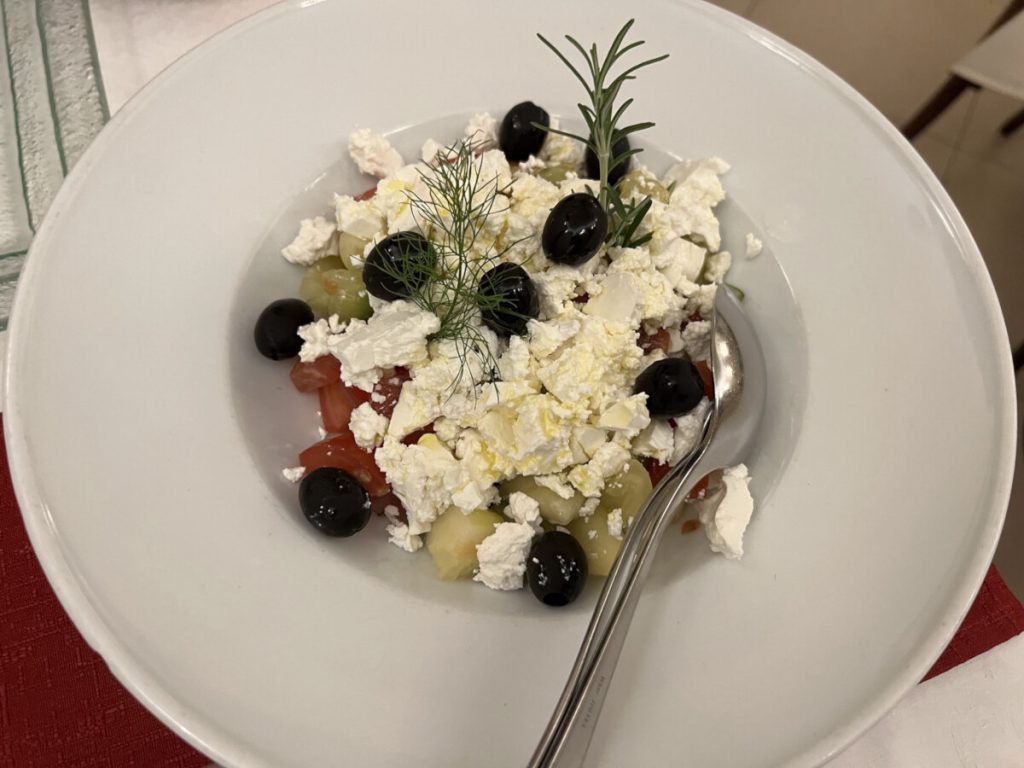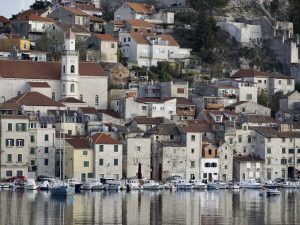Here’s one website’s description of Hum, Croatia:
Hum is a fairytale-esque village in Istria known for being the smallest city in the world, situated 14 kilometers from Buzet. This petite village has only 30 inhabitants and 2 streets. Hum’s size may be notable, but the city itself is also a monument of architecture and culture of the Middle Ages. Its history is rich and unusual.”
Wow, this place sounds awesome. Let’s go check it out.
Maybe it was the time of the year and maybe we were over-saturated with the past two days of seeing some truly lovely seaside towns and mountaintop villages, but here’s my summary of the world’s smallest city can be expressed with the world’s smallest sentence: “Ho hum”. Unless you want to tell your grandchildren that you’ve been to the world’s smallest city, you can definitely find better places to spend your time in Istria. Even Wikipedia doesn’t have a whole lot to say about Hum.
The only exciting thing that happened in our visit to Hum is that we followed to coach buses up the mountain and got to watch some harrying moments as they negotiated the switchbacks and encountered a car coming the other way. The really exciting part though was when we arrived in the practically empty parking lot at the top and then watched these buses disgorge their full load of middle school kids on a field trip. Call it good luck or call it bad luck, the main attraction of our visit was watching the rambunctious kids storm this sleepy little hamlet like a full frontal assault in the age of siege warfare. For a town of 30 people, 100 middle schoolers definitely was a full-scale invasion.


Once we squeezed our way past the school group and the poor teacher trying to corral these kids, we walked up one street for a block then down the street over for a block then looped around the church and that was it. Hum was done. I can see why this place might be appealing to a tour bus of senior citizens (it’s impossible to walk far) but I’m baffled why you would bring middle schoolers to this town. Maybe the kids were taking AP Croatian Civics and wanted to see that you can have a functional city government with less than three dozen people.
In fairness to Hum, we did not visit the town’s one museum so perhaps I missed the opportunity to share some amazing history.
One thing we did learn was the history of Galgolitic script which was a 9th century forerunner to the Cyrillic alphabet used in Eastern Europe. Saint Cyril was from Thessalonika in Greece but he was sent to Christianize the western Slavs and he basically created an alphabet in order to write scripture in the Slavic language. At the gates of Hum, you can see rocks inscribed with Galgolitic script. Looks like something from Game of Thrones (note: I have never seen Game of Thrones). History runs deep in this part of the world.
On a related note, we also have learned that Croatians and Serbs speak very similar languages and can communicate verbally with each other relatively easily. However, Serbian uses the Cyrillic alphabet whereas Croatian uses the Latin alphabet (with a ton of accent marks that are strange to English speakers). Although Serbs and Croats can have a conversation, reading is nearly incomprehensible without some knowledge of the other alphabet. In the Venn diagram of Balkan identity issues, the other major distinction between these groups is that Serbs are mostly Eastern Orthodox (Byzantine) Catholics where as Croats are mostly Roman Catholics. I need to qualify all of this with a reminder that I am neither a scholar nor Balkan native. I’m just a short-term visitor so my attempt at understanding could be completely flawed and perhaps even offensive in some unintentional way to one of these groups. If so, I truly intended no harm.


We don’t regret stopping in Hum, especially because it wasn’t far off our route. We had started in Novigrad on the west side of Istria and were heading to Opatjia, near Rijeka, on the east side peninsula. We got back in the car and continued our drive. I think the middle schoolers were eating their lunches when we left and would love to know where they were heading next.
Opatjia (pronounced Oh-POT-eeya)
A lot of websites promoting Istrian tourism say nothing about Opatjia. Although this town is technically on the Istrian peninsula, it sits at the very northeast extremity AND it’s on the other side of the mountainous barrier that has made Istria somewhat unique from the rest of Croatia for the past 2,000 years. Opatjia is essentially the Fort Lauderdale of Croatia and shares the same bay as the city of Rijeka (third largest city in Croatia with a population of 110,000).
We didn’t know any of this when the super friendly lady at Hertz recommended we visit Opatjia. in fact, by this point in our trip we were reading about places literally as we were driving to them so we had no expectations and had been conditioned by the past two days to expect a sleepy little seaside town. This only added to our delight when we eventually saw Opatjia. But first we had to get there.
We knew we had to cross the mountains and we decided to save a couple kuna by avoiding the tolled highway. Besides, we had been on that road already coming from Zagreb on the bus and what’s the fun of traveling if you take the same road twice? We thus ended up crossing the 1,000m mountains on secondary roads in our manual Kia Picanto. As we ascended, the temperatures dropped and our 3-cylinder workhorse got pushed to its limits. At the top, we passed through the Ucka nature park but chose not to stop because the light was fading and the sky looked like it might rain (or snow?). We did stop just long enough to snap a photo of Rijeka way below us.

What we discovered coming down the east side of the Ucka mountain range is that Optjia is one of several towns tucked along the coast at the base of the mountains and they are all loaded with seaside hotels, resorts, and boardwalks. Its proximity to the urban center of Rijeka gives this area a completely different vibe than the rest of Istria. Similar to our hotel the previous night, we got a great off season rate for a room overlooking the Adriatic at the Hotel Mali Raj (Little Paradise).
Not only do each of these towns have their own boardwalk but they are all connected along the coast by a walkway that stretches for miles and offers great scenery and views around every corner. After check-in, we walked north toward Opatjia’s central area and discovered that Advent had arrived in Istria. The boardwalk was decorated with lights and booths selling holiday treats and warm wine. Essentially, this was a seaside Christmas market. Apparently, this was the inaugural night and it was clear they were still in the process of setting up more displays and lights, but it was our first taste of Christmas in Croatia, so we celebrated with a mulled wine on a chilly and overcast Adriatic evening.


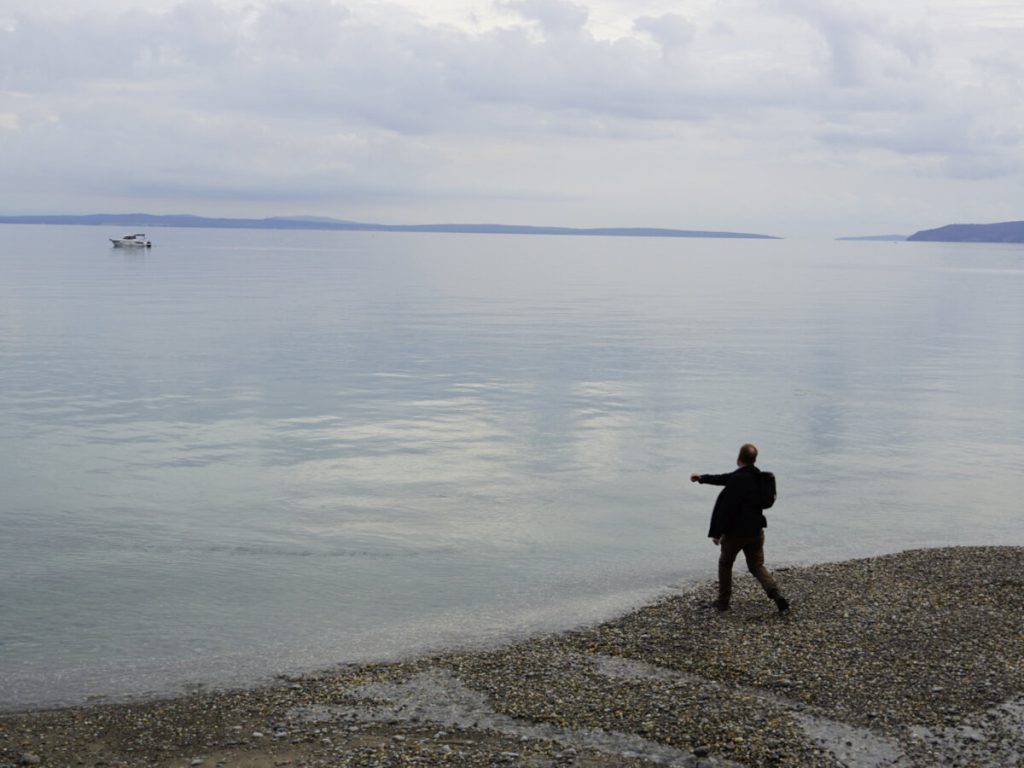


Back at the Mali Raj, we had supper across the street at the Pizzeria Venezia (awesome food and value) then went back and watched some World Cup actio. From seashore to seashore, across Istria, and over the mountain, this was not your typical Black Friday, but certainly another memorable day.
The next morning, we put on our walking shoes and headed south to see just how far this awesome walkway goes along the coast. For better or worse, we never got there because it was longer than what our feet or time permitted. We made it as far as the town of Lovran, three miles to the south before turning around. It was cool and bit windy, but overall an excellent morning for a brisk walk and enjoying the scenery.












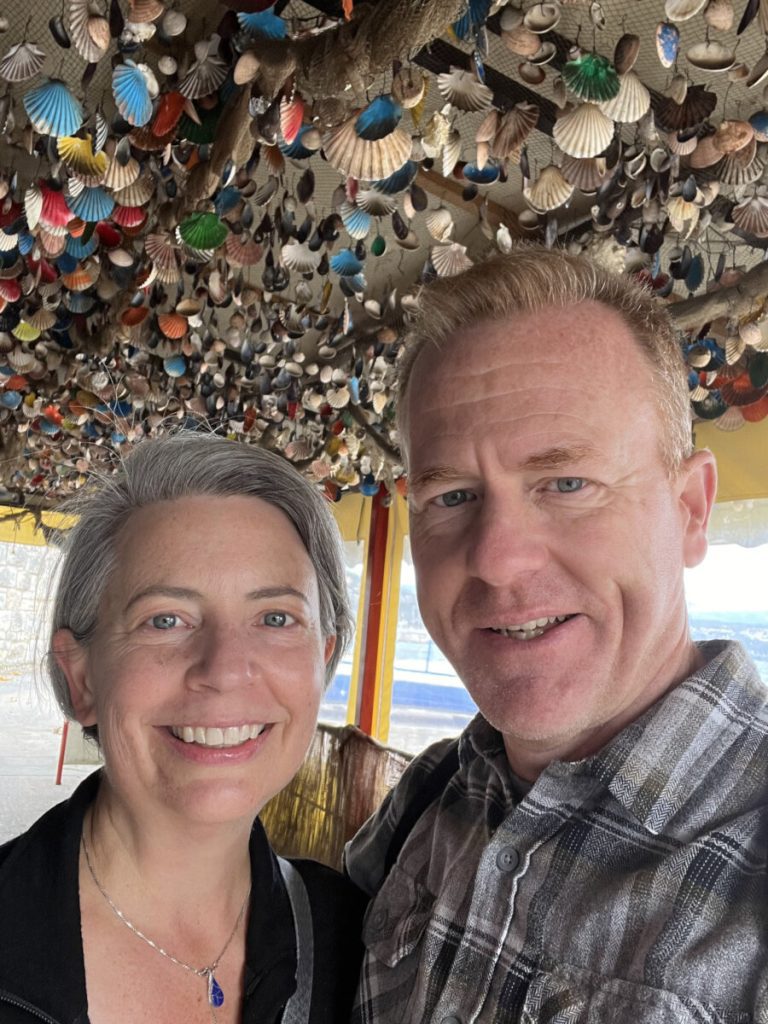
We came into Opatji over the mountain from the north and we departed driving south along the coastal road. This was a much gentler way around the mountain and included an overlook of a deep inlet and the coal-fired Plomin electric plant. The picture frame has been covered in stickers, mostly by motorcycle club, which are almost as interesting as the view itself.


Kamenjack National Park
On the drive back to Pula, we stopped at Istria’s southernmost peninsula called Kamenjack (pronounced Com-en-YACK). The town of Prementura (the decoy for the airship bombers in WWI) sits at the entrance to the park. The roads were unpaved so we bounced along in the Kia Picanto for a few kilometers before parking. Being on a narrow peninsula, Kamenjack was not surprisingly windy. It was also quite chilly. We did our best to enjoy the hike but eventually conceded that it’s probably a much nicer place to visit in July. We got one good sunset photo of the lighthouse offshore not knowing that 15 hours later we’d be cruising past it at sunrise on the ferry from Pula to Zadar.

On our way to dropping the car at Pula Airport, we stopped to fill the tank. $44 dollars for seven gallons, which is consistent with our previous car rentals in Spain and Iceland.
We met our Hertz lady and she was once again brimming with energy and friendliness. She even saved us a taxi fare and gave us a ride back into town, talking the whole way.
Advent
We enjoyed our three days of road trip adventure and got a pretty broad, if not deep, sampling of the communities that make up Istria. However, it felt really nice to be back in Pula and we felt a bit sentimental about having to leave early the next morning. We walked to the city center for a final meal and were pleased to discover that Advent had arrived in Pula. All of the decorations and preparations we had been seeing earlier in the week were lighted and open, including a little park with amusement rides for children, and a full ice rink in one of the plazas.
Croatian kids don’t sit on Santa’s lap to tell him what they want. Instead, they visit Santa’s helpers by the kiddy rides and write him a letter at child-sized picnic tables. See photo #3 below. How awesome is that?
The curved street that rings the hill was lighted brilliantly and they had a stage set up in the plaza by the Arch of Sergii and the statue of James Joyce. Once again, we felt blessed to have chosen pretty Pula as our home base in Istria.



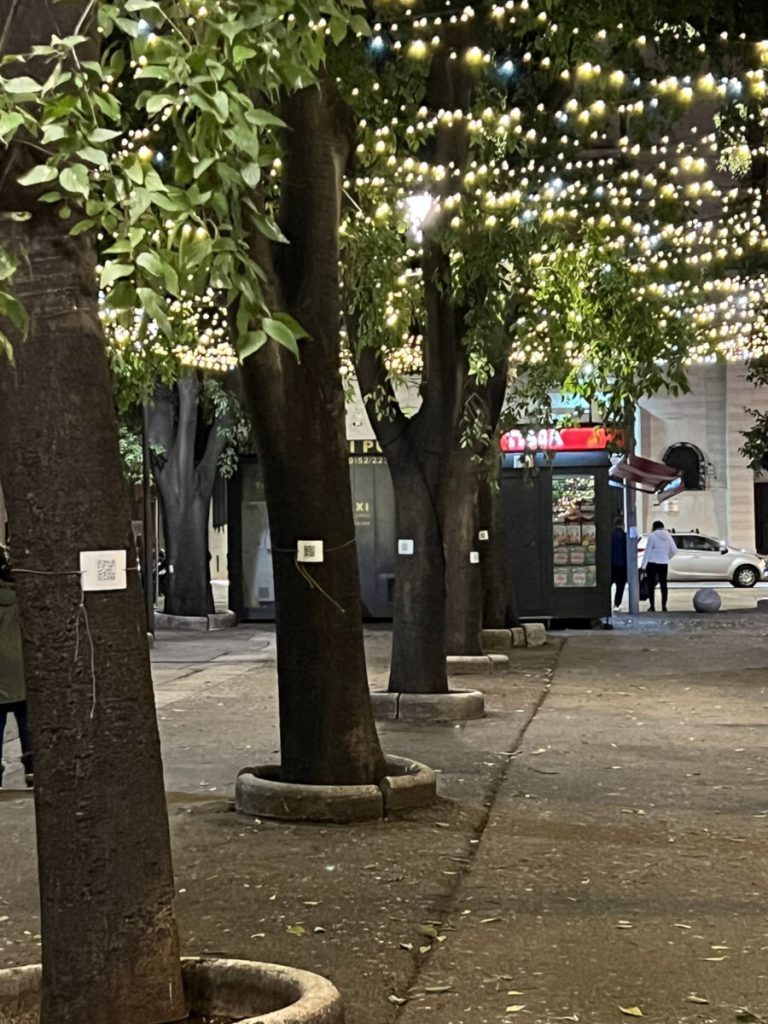


Farewell, Istria
The next morning, we had to wake up EARLY to make the 7:00 a.m. ferry from Pula to Zadar. The pre-dawn was completely still so we enjoyed our half mile walk (downhill thankfully) from the apartment to the ferry pier. It took us past the amphitheater one more time. When we arrived at the ferry at 0640, they told us we were too early and had to wait, so we took a few photos in the morning stillness.
The ferry itself had a capacity for several hundred passengers but only seven or eight people got on the boat with us. The route to Zadar included stops at four different islands so we weren’t sure if we’d be seeing more people or not. All we knew is that the ferry experience felt a lot like our other experiences with visiting Istria in the off-season. We left port just as the sun came over the horizon. Once we cleared the harbor, though, the rest of the morning was anything but still.

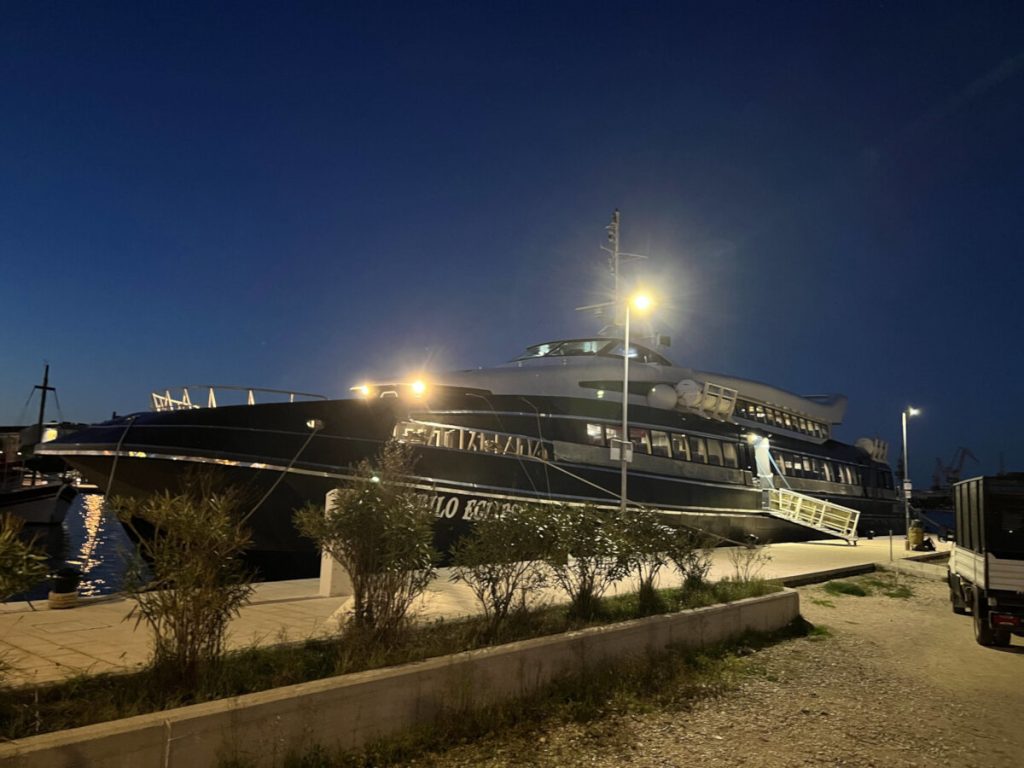






Food Addendum
Istria is famous for its cuisine. I’ve said before we are not foodies, but the food is definitely part of the adventure. For those who enjoy looking at pictures of other people’s meals, this section is a compilation of some things we had that didn’t make the cut in the other posts. We had our share pizzas and salads.






